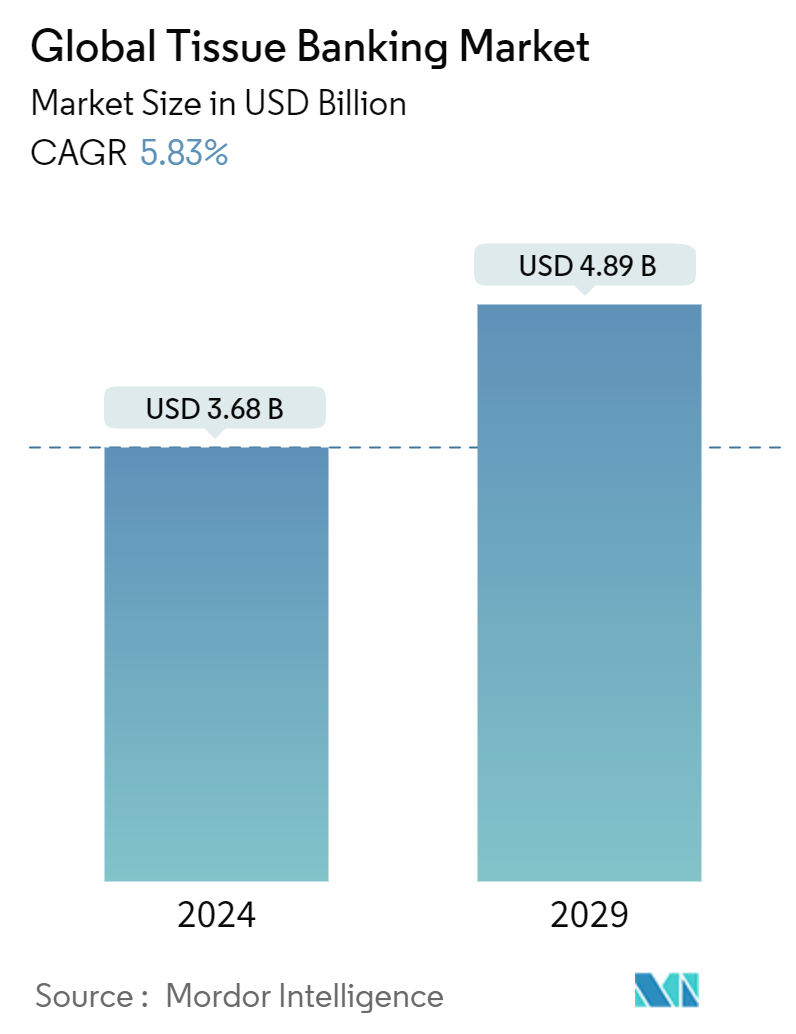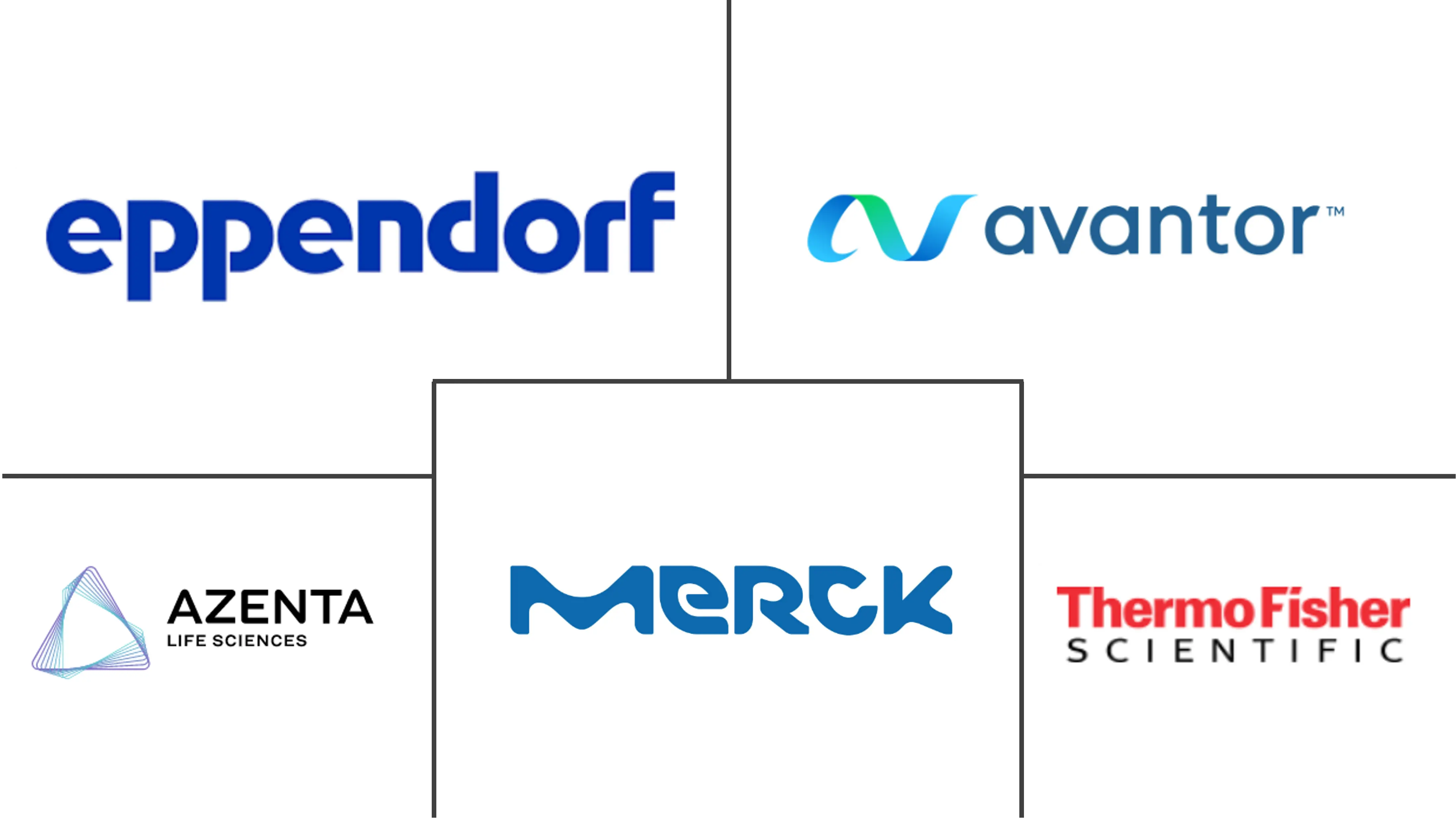Market Size of Global Tissue Banking Industry

| Study Period | 2019 - 2029 |
| Market Size (2024) | USD 3.68 Billion |
| Market Size (2029) | USD 4.89 Billion |
| CAGR (2024 - 2029) | 5.83 % |
| Fastest Growing Market | Asia Pacific |
| Largest Market | North America |
Major Players
*Disclaimer: Major Players sorted in no particular order |
Tissue Banking Market Analysis
The Global Tissue Banking Market size is estimated at USD 3.68 billion in 2024, and is expected to reach USD 4.89 billion by 2029, growing at a CAGR of 5.83% during the forecast period (2024-2029).
The sudden emergence of COVID-19 had a significant impact on the market studied. According to various research studies, tissue distribution has been greatly reduced because of the decrease in surgical activity in the initial days of the COVID-19 pandemic. It was also reported that during the very initial period, a general drop in the number of tissue donors had been observed in various countries globally. Due to the cancellation of elective operations, there was a scarcity of tissues, and the available tissues were only utilized in urgent surgical interventions or medical procedures. These impacted the studied market adversely.
However, during the later pandemic, the trend for stem cell research increased to find effective vaccines for COVID-19 infection. For instance, according to a research article published in the Stem Cell Research and Therapy journal in January 2022, cell therapy is a significant treatment applied in several diseases, including lung, cardiovascular, liver, kidney, and other diseases. Thus these are anticipated to find a cure for COVID-19. Also, as per the source above, stem cell therapy and stem cell-derived organoid models received huge attention as a new treatment and research method for COVID-19. Therefore, such instances indicate that the pandemic had a considerable impact on the market growth, and it is expected to continue its growth over the forecast period.
The rising healthcare expenditure, the growing burden of chronic diseases, and technological advances in drug discovery and development are the major drivers for the tissue banking market. For instance, according to September 2022 update by WHO, chronic diseases have always been a massive global challenge, and they accounted for approximately 74% of all deaths worldwide in 2021. Furthermore, according to the September 2021 update by IDF, around 537.0 million adults (20-79 years) were living with diabetes in 2021, and around 643 million and 783 million people are expected to live with diabetes by 2030 and 2045, respectively.
In addition, as per the Global Cancer Observatory data updated in March 2021, nearly 19.3 million new cases of cancer were diagnosed in 2020 globally among both men and women. The same source reported that the incidence of cancer was growing at a rapid pace in the world and estimated that the number of new cases of cancer in both sexes is projected to reach around 30.2 million by 2040. Thus, with the increasing number of chronic diseases, the demand for tissue banks is anticipated to increase as tissues are generally used in research activities related to diseases and the diagnosis and treatment of diseases. Therefore, such factors are anticipated to propel the tissue banking market growth over the forecast period.
However, a stringent regulatory scenario is expected to hinder market growth over the forecast period.
Tissue Banking Industry Segmentation
As per the scope of the report, tissue banks facilitate the collection and banking of human tissues. These tissues play an important role in many applications associated with healthcare. The Tissue Banking Market is Segmented by Product (Equipment and Media and Consumables), Application (Therapeutics, Medical Research, and Other Applications), and Geography (North America, Europe, Asia-Pacific, Middle East and Africa, and South America). The market report also covers the estimated market sizes and trends for 17 different countries across major regions globally. The report offers the value (in USD million) for the above segments.
| By Product | ||||||
| ||||||
| Media and Consumables |
| By Application | |
| Therapeutics | |
| Medical Research | |
| Other Applications |
| Geography | ||||||||
| ||||||||
| ||||||||
| ||||||||
| ||||||||
|
Global Tissue Banking Market Size Summary
The tissue banking market is poised for steady growth, driven by increasing healthcare expenditures, the rising prevalence of chronic diseases, and advancements in drug discovery and development. The market experienced initial setbacks due to the COVID-19 pandemic, which led to a decrease in surgical activities and a temporary drop in tissue donations. However, the later stages of the pandemic saw a surge in stem cell research, which contributed to the market's recovery and growth. The demand for tissue banks is expected to rise as they play a crucial role in research and treatment of various diseases, including cancer, diabetes, and cardiovascular conditions. Despite the challenges posed by stringent regulatory environments, the market is anticipated to expand, supported by the growing use of human tissues in medical research and the development of new therapies.
North America is projected to lead the tissue banking market, fueled by increased research activities, a high incidence of chronic diseases, and a robust pharmaceutical industry. The region's market growth is further bolstered by significant investments in tissue banking projects and collaborations among key industry players. The competitive landscape is characterized by the presence of both global and regional companies, with major players like Avantor, Inc., Merck KGaA, and Thermo Fisher Scientific, Inc. actively contributing to market dynamics. Initiatives such as the establishment of new tissue banks and partnerships for innovative programs are expected to enhance the market's growth trajectory in North America and beyond.
Global Tissue Banking Market Size - Table of Contents
-
1. MARKET DYNAMICS
-
1.1 Market Overview
-
1.2 Market Drivers
-
1.2.1 Rising Healthcare Expenditure
-
1.2.2 Growing Burden of Chronic Diseases
-
1.2.3 Technological Advances in Drug Discovery and Development
-
-
1.3 Market Restraints
-
1.3.1 Stringent Regulatory Scenario
-
-
1.4 Porter Five Forces
-
1.4.1 Threat of New Entrants
-
1.4.2 Bargaining Power of Buyers/Consumers
-
1.4.3 Bargaining Power of Suppliers
-
1.4.4 Threat of Substitute Products
-
1.4.5 Intensity of Competitive Rivalry
-
-
-
2. MARKET SEGMENTATION (Market Size by Value - USD Million)
-
2.1 By Product
-
2.1.1 Equipment
-
2.1.1.1 Cryopreservation Equipment
-
2.1.1.2 Thawing Equipment
-
2.1.1.3 Quality Control Equipment
-
2.1.1.4 Others
-
-
2.1.2 Media and Consumables
-
-
2.2 By Application
-
2.2.1 Therapeutics
-
2.2.2 Medical Research
-
2.2.3 Other Applications
-
-
2.3 Geography
-
2.3.1 North America
-
2.3.1.1 United States
-
2.3.1.2 Canada
-
2.3.1.3 Mexico
-
-
2.3.2 Europe
-
2.3.2.1 Germany
-
2.3.2.2 United Kingdom
-
2.3.2.3 France
-
2.3.2.4 Italy
-
2.3.2.5 Spain
-
2.3.2.6 Rest of Europe
-
-
2.3.3 Asia-Pacific
-
2.3.3.1 China
-
2.3.3.2 Japan
-
2.3.3.3 India
-
2.3.3.4 Australia
-
2.3.3.5 South Korea
-
2.3.3.6 Rest of Asia-Pacific
-
-
2.3.4 Middle East and Africa
-
2.3.4.1 GCC
-
2.3.4.2 South Africa
-
2.3.4.3 Rest of Middle East and Africa
-
-
2.3.5 South America
-
2.3.5.1 Brazil
-
2.3.5.2 Argentina
-
2.3.5.3 Rest of South America
-
-
-
Global Tissue Banking Market Size FAQs
How big is the Global Tissue Banking Market?
The Global Tissue Banking Market size is expected to reach USD 3.68 billion in 2024 and grow at a CAGR of 5.83% to reach USD 4.89 billion by 2029.
What is the current Global Tissue Banking Market size?
In 2024, the Global Tissue Banking Market size is expected to reach USD 3.68 billion.

